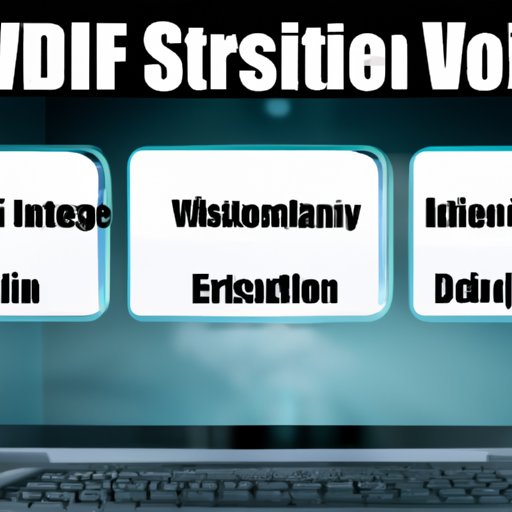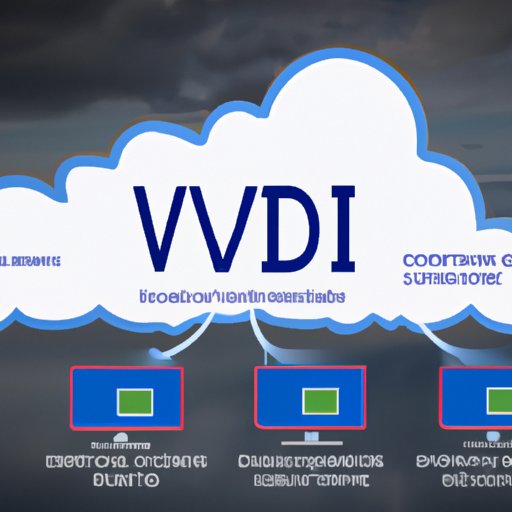Introduction
Virtual Desktop Infrastructure (VDI) is a type of technology that allows businesses to provide their employees with access to a secure, virtualized desktop environment. This technology has become increasingly popular in recent years as it offers many advantages for businesses, such as improved security, cost savings, flexibility, and scalability. In this article, we will explore what VDI technology is, the benefits it can offer, and how businesses can implement it.

Exploring VDI Technology: What It Is and How It Can Benefit Your Business
Before diving into the details of VDI technology, let’s first define what it is. Virtual Desktop Infrastructure (VDI) is a type of technology that enables businesses to securely provide their employees with access to a virtualized desktop environment. Instead of providing physical computers to each employee, VDI creates a virtualized version of a desktop computer which can be accessed from any device. This allows businesses to save money on hardware costs, reduce maintenance costs, and improve security.
The advantages of implementing VDI solutions are numerous. According to a study by IDC, businesses that have implemented VDI solutions report an average of 30% cost savings, 25% faster application response times, and 20% fewer IT support calls. Additionally, VDI solutions offer enhanced security, increased flexibility, and improved scalability. With VDI, businesses can easily add or remove users, deploy applications quickly and securely, and manage their environments remotely.
A Comprehensive Guide to Virtual Desktop Infrastructure (VDI)
Now that we have established what VDI technology is and the advantages it can offer, let’s take a closer look at how VDI works. Virtual Desktop Infrastructure (VDI) is a type of technology that enables businesses to securely provide their employees with access to a virtualized desktop environment. This is achieved through the use of virtual machines (VMs) which are hosted on a central server or in the cloud. Each VM acts as a separate computer, allowing users to access their own personalized desktop environment from any device.
The different components of VDI include the client device, the host server, the hypervisor, and the network. The client device is the device that the user is using to access the virtual desktop environment. The host server is the physical server where the virtual machines are hosted. The hypervisor is the software that manages the virtual machines, and the network is the connection between the client and the host server. All of these components work together to create the virtual desktop environment.
Security is also an important consideration when implementing VDI solutions. VDI solutions can help businesses protect their data by providing an isolated environment in which all data is stored and accessed. Additionally, VDI solutions offer strong authentication protocols, which can help prevent unauthorized access to the virtual environment. Finally, VDI solutions can help businesses comply with industry regulations, such as HIPAA and GDPR, by providing the necessary security measures.
A Beginner’s Guide to Understanding VDI Technology
Now that we have explored the basics of VDI technology, let’s take a look at what cloud computing is and the different types of VDI solutions available. Cloud computing is a type of technology that allows businesses to access computing resources, such as storage and processing power, over the internet. This means that businesses can access the same resources without having to invest in expensive hardware or software. There are two main types of cloud computing: public clouds and private clouds. Public clouds allow businesses to access computing resources from a shared pool of resources, while private clouds offer businesses their own dedicated resources.
When it comes to VDI solutions, there are several options available. Traditional VDI solutions involve hosting the virtual desktops on a local server, while cloud-hosted VDI solutions allow businesses to access their virtual desktops from the cloud. Additionally, businesses can choose between managed and unmanaged VDI solutions. Managed VDI solutions are typically more expensive but offer more control and customization, while unmanaged VDI solutions are cheaper but offer less control and customization.
Finally, businesses need to consider their requirements when selecting a VDI solution. These requirements may include the number of users, the types of applications needed, the level of security required, and the budget available. Once these requirements have been identified, businesses can select the most suitable VDI solution for their needs.
VDI Solutions: Benefits, Challenges and Considerations
Now that we have explored the basics of VDI technology and the different types of VDI solutions available, let’s take a look at the benefits, challenges and considerations associated with implementing a VDI solution. The benefits of VDI solutions include improved security, cost savings, flexibility, scalability, and faster application response times. Additionally, VDI solutions can help businesses comply with industry regulations, such as HIPAA and GDPR.
However, there are also some challenges associated with VDI solutions. One of the biggest challenges is ensuring that the virtual environment is secure. Another challenge is ensuring that the virtual environment is reliable and that the performance remains consistent. Finally, businesses need to consider the cost of implementing a VDI solution, as well as the additional training that may be required for users.
When considering a VDI solution, businesses should take into account the following key considerations: the number of users, the types of applications needed, the level of security required, the budget available, and the training requirements. Additionally, businesses should ensure that the VDI solution they select meets their specific requirements and is able to scale to meet future demands.

VDI: The Pros and Cons of Implementing This Advanced Technology
Now that we have explored the benefits, challenges and considerations associated with implementing a VDI solution, let’s take a look at the pros and cons of implementing this advanced technology. The pros of implementing VDI include improved security, cost savings, flexibility, scalability, and faster application response times. Additionally, VDI solutions can help businesses comply with industry regulations, such as HIPAA and GDPR.
On the other hand, there are some drawbacks associated with VDI solutions. One of the biggest drawbacks is the cost of implementation, as well as the additional training that may be required for users. Additionally, there is always the risk of security breaches, as well as the potential for performance issues due to network congestion. Finally, businesses need to ensure that the VDI solution they select meets their specific requirements and is able to scale to meet future demands.
The Future of Work: How VDI is Revolutionizing the Way We Work
As more businesses move towards remote working and adopt advanced technologies, such as VDI, the way we work is being revolutionized. The rise of remote working has enabled businesses to access new markets and expand their reach, while also providing their employees with more freedom and flexibility. Additionally, VDI solutions can help businesses reduce costs, improve security, and increase efficiency.
VDI solutions can also help businesses ensure compliance with industry regulations, such as HIPAA and GDPR. Additionally, VDI solutions can help businesses keep up with the latest trends and technology, such as artificial intelligence and machine learning. Finally, VDI solutions can help businesses improve collaboration and communication, as well as enable them to access resources from anywhere in the world.
Conclusion
In conclusion, VDI technology is an advanced technology that can provide businesses with numerous benefits, such as improved security, cost savings, flexibility, and scalability. When selecting a VDI solution, businesses should consider their requirements, such as the number of users, the types of applications needed, the level of security required, and the budget available. Additionally, businesses should take into account the pros and cons of implementing VDI, as well as the impact it can have on the workplace. Ultimately, VDI is an advanced technology that can help businesses revolutionize the way they work.
(Note: Is this article not meeting your expectations? Do you have knowledge or insights to share? Unlock new opportunities and expand your reach by joining our authors team. Click Registration to join us and share your expertise with our readers.)
